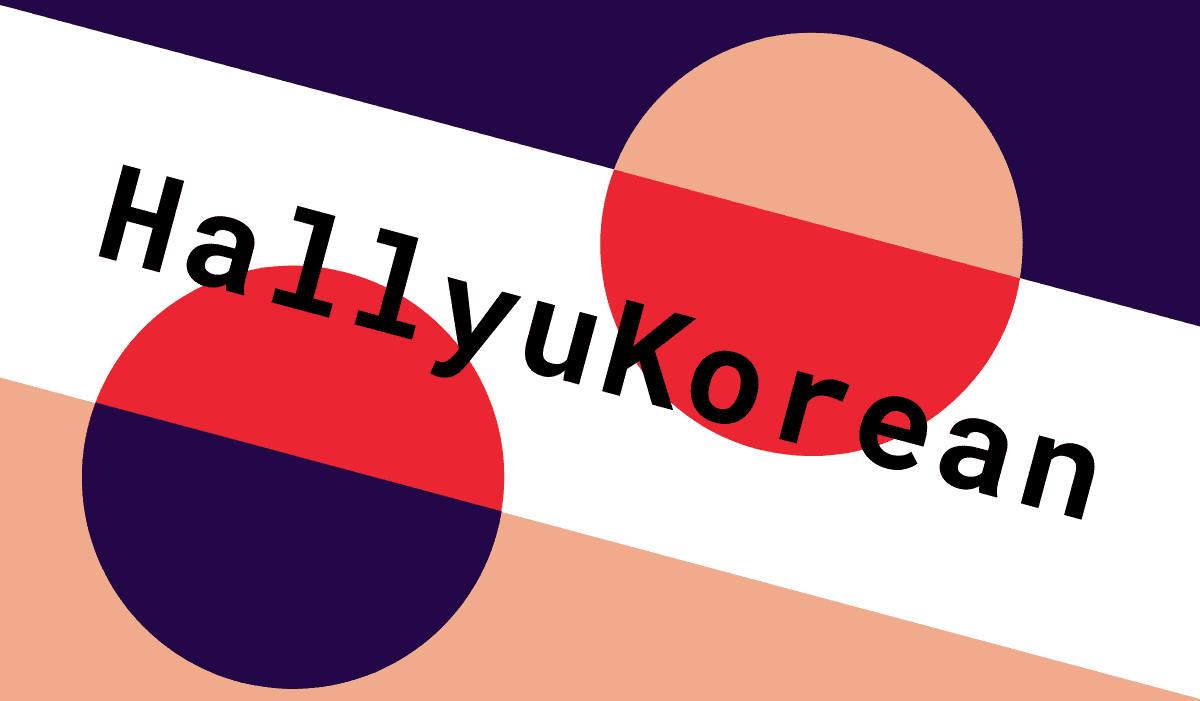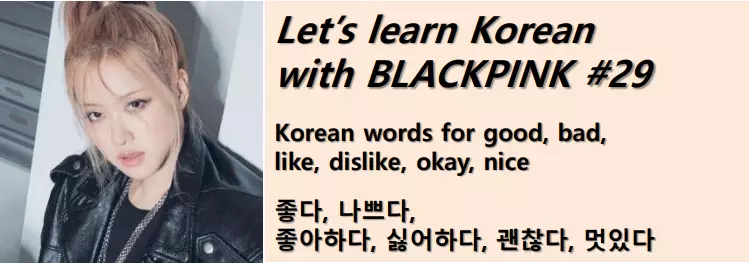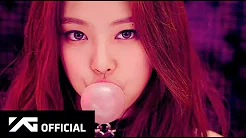Korean words for good, bad, like, dislike, okay, nice : 좋다, 나쁘다, 좋아하다, 싫어하다, 괜찮다, 멋있다
Let’s learn Korean words for good, bad, like, dislike, okay, nice with BLACKPINK lyrics.
Click the play button below to listen to all the BLACKPINK lyrics used in this post.
좋다 [jo-ta] to be good, to like
좋아. 난 지금 네가 좋아
jo-a. nan ji-geum ne-ga jo-a
All right, I like you at this moment
*좋아(all right) +
난(나(I) + 는(topic particle), =난) +
지금(now) +
네가(너(you) + 가(subject particle), =네가) +
좋아(like)
나쁘다 [na-ppeu-da] to be bad
나쁠 거 없잖아
na-ppeul geo eop-ja-na
There’s nothing bad about it
*나쁠(나쁘다(be bad) + ㄹ(noun modifier)) +
거(thing) +
없잖아 (없다(don’t have) ~잖아(as you know))
(*~잖아(요) reminds the listener of something or rebukes the listener indirectly.
~잖아(요) is the same as ‘as you know’, ‘didn’t I say that~’ in English.)
좋아하다 [jo-a-ha-da] to like
내 뒷모습을 좋아하던 너
nae dwit-mo-seu-beul jo-a-ha-deon neo
You liked seeing my back
*내(나(I) + 의(of), =내) +
뒷모습(뒤(back) + 모습(appearance)) + 을(object particle) +
좋아하던(좋다(like) + ~아하다 + ~던(noun modifier for past tense)) +
너(you)
(*Adjective stem + ~아/어/해하다 is used to express the speaker’s feeling of observing something.
By adding ~아/어/해하다, the adjective becomes a verb.
뒤(back) + 모습(appearance) = 뒷모습(O), 뒤모습(X)
In compound words, ㅅ is sometimes added when the preceding word ends in a vowel, such as 뒷모습. But even Koreans have trouble with that, so let’s just move on.)
싫다 [sil-ta] to hate, to dislike
싫어하다 [si-leo-ha-da] to dislike, to hate
보기 싫었던 나와 마주할래
bo-gi si-leot-deon na-wa ma-ju-hal-lae
I’ll face the me I didn’t want to see
*보기(보다(see) + ~기) +
싫었던(싫다(dislike) + ~었던(noun modifier for past tense)) +
나(I) + 와(with) +
마주할래(마주하다(face) + ~ㄹ래(would like to))
(*Verb stem + ~기 : adding ~기 to a verb stem makes the verb a noun.
Verb stem + ~던 is used to recall a past action or habit that has been repeated often or is still present.
Verb stem + ~았/었던 is used to recall a past event that has not continued into the present
~ㄹ/을래(요) can be used to indicate that the speaker wants to do something.)
괜찮다 [gwaen-chan-ta] to be okay
나 혼자여도 괜찮아. 불쌍해하지 마
na hon-ja-yeo-do gwaen-cha-na. bul-ssang-hae-ha-ji ma
I’m okay being alone. Don’t feel bad for me
*나(I) +
혼자여도(혼자(alone) + 이다(be) + 아/어도(even if)) +
괜찮아(be okay) +
불쌍해하지 마(불쌍하다(be sorry) + ~해하다 + ~지 마(do not))
(*Adjective stem + ~아/어/해하다’ is used to express the speaker’s feeling of observing something.
By adding ~아/어/해하다, the adjective becomes a verb.)
멋있다 [meo-si-tta] to be nice, to be cool
정말 멋있어 오늘 밤
jeong-mal meo-si-sseo o-neul bam
You’re so cool tonight
*정말(really) +
멋있어(be nice) +
오늘(today) +
밤(night)
Grammar Reference
*Adjective stem + ~아/어/해하다 is used to express the speaker’s feeling of observing something.
By adding ~아/어/해하다, the adjective becomes a verb.
ex)불쌍해하지 마: 불쌍하다(be sorry) + ~해하다 + ~지 마(do not)
Adjective stem + ~아/어하다 is used to express the feeling of observation by the speaker about something.
After removing 다 from the root verb, if the verb stem ends with 아 or 오 then ~아하다 is added.
If the verb stem ends with anything other than 오 or 아 then ~어하다 has to be added.
Also, if the verb stem ends with 하 then ~해하다 has to be added.
*Verb stem + ~기 : adding ~기 to a verb stem makes the verb a noun.
ex)보기 : 보다(see) + ~기
*Tense
*Present tense : Adjective/verb stem + ~아/어/해요
*Past tense : Adjective/verb stem + ~았/었/했어요
*Future tense : Adjective/verb stem + ~(으)ㄹ 거예요 / ~ㄹ 게요/ ~겠어요
The basic way to get the verb/adjective stem is to remove 다 from the verb/adjective.
If there is a vowel ㅏ or ㅗ on the final syllable of the adjective/verb stem, 아요(present tense), 았어요(past tense), 을 거예요(future tense) is used.
If there is a vowel other than ㅏ or ㅗ on the final syllable of the adjective/verb, 어요(present tense), 었어요(past tense), ㄹ 거예요(future tense) is used.
Also, if there is 하다 in the adjective/verb, 하다 changes to 해요(present tense), 했어요(past tense), 할 거예요(future tense).
Below you can see the conjugation of 좋다, 나쁘다, 좋아하다, 싫어하다, 괜찮다, 멋있다 by tenses.
| Present tense | Past tense | Future tense | |
| 좋다 | 좋아요 | 좋았어요 | 좋을 거예요 |
| 나쁘다 | 나빠요 | 나빴어요 | 나쁠 거예요 |
| 좋아하다 | 좋아해요 | 좋아했어요 | 좋아할 거예요 |
| 싫어하다 | 싫어해요 | 싫어했어요 | 싫어할 거예요 |
| 괜찮다 | 괜찮아요 | 괜찮았아요 | 괜찮을 거예요 |
| 멋있다 | 멋있어요 | 멋있었어요 | 멋있을 거예요 |
*Speech levels
The three most commonly used Korean speech levels are 합쇼체 (formal polite), 해요체 (informal polite) and 해체 (informal plain).
*The formal polite style : Adjective/verb stem + ~(스)ㅂ니다
~(스)ㅂ니다 is used more in formal or public situations including the military, news, reporting presentations, meetings and lectures. It’s mainly used to address large gatherings or people you don’t know personally.
*The informal polite style : Adjective/verb stem + ~아/어/해요
~아/어/해요 is most commonly used in everyday life. Compared to the formal polite style, the informal polite style is softer and less formal, so it is mainly used among family members, friends, shopkeepers and other close acquaintances.
*The informal plain style : Adjective/verb stem + ~아/어/해
As for the informal plain style ~아/어/해, it is mainly used among friends from superiors to people of lower rank and among family members.
Below you can see the conjugation of 좋다, 나쁘다, 좋아하다, 싫어하다, 괜찮다, 멋있다 by speech levels.
| Formal polite | Informal polite | Informal plain | |
| 좋다 | 좋습니다 | 좋아요 | 좋아 |
| 나쁘다 | 나쁩니다 | 나빠요 | 나빠 |
| 좋아하다 | 좋아합니다 | 좋아해요 | 좋아해 |
| 싫어하다 | 싫어합니다 | 싫어해요 | 싫어해 |
| 괜찮다 | 괜찮습니다 | 괜찮아요 | 괜찮아 |
| 멋있다 | 멋있습니다 | 멋있어요 | 멋있어 |
BLACKPINK music video to enjoy
Well done for making it this far.
Watch the 붐바야 (BOOMBAYAH) music video above and see if you can hear “좋아. 난 지금 네가 좋아”, which you learned today.


